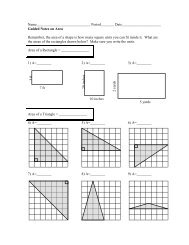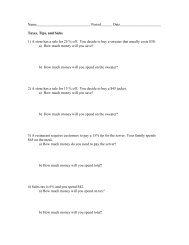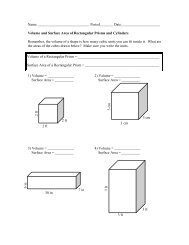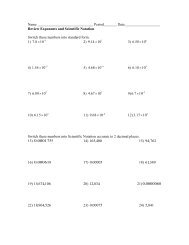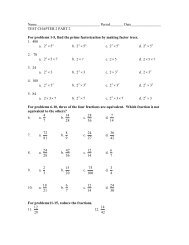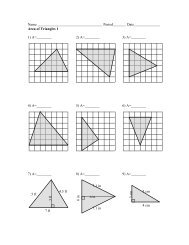A line is drawn with an arrow pointing in both ... - The McNabbs
A line is drawn with an arrow pointing in both ... - The McNabbs
A line is drawn with an arrow pointing in both ... - The McNabbs
Create successful ePaper yourself
Turn your PDF publications into a flip-book with our unique Google optimized e-Paper software.
Name_______________________________ Period_______ Date___________________Parts of a L<strong>in</strong>eA _______ <strong>is</strong> <strong>drawn</strong> <strong>with</strong> <strong>an</strong> <strong>arrow</strong> <strong>po<strong>in</strong>t<strong>in</strong>g</strong> <strong>in</strong> <strong>both</strong> directions. <strong>The</strong> <strong>arrow</strong>s me<strong>an</strong> thatthe <strong>l<strong>in</strong>e</strong> goes on forever.To tell the difference between different <strong>l<strong>in</strong>e</strong>s, we use two po<strong>in</strong>ts on them.ABCDWe say th<strong>is</strong> <strong>is</strong> “LINE AB”.We say th<strong>is</strong> <strong>is</strong> “LINE CD.”We write th<strong>is</strong> asAB orBA .We write th<strong>is</strong> asCD orDC .What if there <strong>is</strong> more th<strong>an</strong> one po<strong>in</strong>t on a <strong>l<strong>in</strong>e</strong>? Simple. It just me<strong>an</strong>s that it has morenames.W X YWX ,XW ,We c<strong>an</strong> call th<strong>is</strong>are talk<strong>in</strong>g about the same <strong>l<strong>in</strong>e</strong>.WY ,YW ,WY , orYW . All of theseA ____________ <strong>is</strong> a specific part of the <strong>l<strong>in</strong>e</strong> from one po<strong>in</strong>t to <strong>an</strong>other. We drawthem <strong>with</strong> po<strong>in</strong>ts on <strong>both</strong> ends. Th<strong>is</strong> me<strong>an</strong>s that we are talk<strong>in</strong>g about a certa<strong>in</strong> d<strong>is</strong>t<strong>an</strong>ce.You c<strong>an</strong> always take a ruler <strong>an</strong>d say how long it <strong>is</strong>. You c<strong>an</strong>’t do that <strong>with</strong> a <strong>l<strong>in</strong>e</strong>.ABCDWe say th<strong>is</strong> <strong>is</strong> “LINE SEGMENT AB.”We write th<strong>is</strong> as AB or BA .We say th<strong>is</strong> <strong>is</strong> “LINE SEGMENT CD.”We write th<strong>is</strong> as CD or DC .A _______ <strong>is</strong> a comb<strong>in</strong>ation of a <strong>l<strong>in</strong>e</strong> segment <strong>an</strong>d a <strong>l<strong>in</strong>e</strong>. It always starts at a po<strong>in</strong>t<strong>an</strong>d then goes forever.We say th<strong>is</strong> <strong>is</strong> “RAY AB.”We write th<strong>is</strong> asTh<strong>is</strong> <strong>is</strong> not the same asAB .BAAABB
Look atFG. F<strong>in</strong>d the length of the <strong>in</strong>dicated <strong>l<strong>in</strong>e</strong> segments.1)F G H I J KFG = ______ <strong>in</strong>ches 2)FH = ______ <strong>in</strong>ches3)HK = ______ <strong>in</strong>ches 4)HJ = ______ <strong>in</strong>ches5)IG = ______ <strong>in</strong>ches 6)KG = ______ <strong>in</strong>chesA _____________ <strong>is</strong> a po<strong>in</strong>t that <strong>is</strong> <strong>in</strong> the middle of a <strong>l<strong>in</strong>e</strong> segment.For example: X <strong>is</strong> the midpo<strong>in</strong>t ofAB. X <strong>is</strong> also the midpo<strong>in</strong>t ofQW .Q A X B WIf R <strong>is</strong> the midpo<strong>in</strong>t of AJ <strong>in</strong> the picture below, then what are the lengths of thefollow<strong>in</strong>g <strong>l<strong>in</strong>e</strong> segments?A B C D E R F G H I J7)AB = ______ <strong>in</strong>ches 8)DE = ______ <strong>in</strong>ches9) RG = ______ <strong>in</strong>ches 10)11) RA = ______ <strong>in</strong>ches12)BF = ______ <strong>in</strong>chesCE = ______ <strong>in</strong>ches_____________ are <strong>l<strong>in</strong>e</strong>s thatwill never cross._______________ are <strong>l<strong>in</strong>e</strong>sthat cross at a 90 0 <strong>an</strong>gle.
Look atFG. F<strong>in</strong>d the length of the <strong>in</strong>dicated <strong>l<strong>in</strong>e</strong> segments.1)F G H I J KFG = __1___ <strong>in</strong>ches 2)FH = __ 2___ <strong>in</strong>ches3)HK = __3___ <strong>in</strong>ches 4)HJ = ___2___ <strong>in</strong>ches5)IG = ___2___ <strong>in</strong>ches 6)KG = ___4___ <strong>in</strong>chesA Midpo<strong>in</strong>t <strong>is</strong> a po<strong>in</strong>t that <strong>is</strong> <strong>in</strong> the middle of a <strong>l<strong>in</strong>e</strong> segment.For example: X <strong>is</strong> the midpo<strong>in</strong>t ofAB. X <strong>is</strong> also the midpo<strong>in</strong>t ofQW .Q A X B WIf R <strong>is</strong> the midpo<strong>in</strong>t of AJ <strong>in</strong> the picture below, then what are the lengths of thefollow<strong>in</strong>g <strong>l<strong>in</strong>e</strong> segments?A B C D E R F G H I J7)AB = __1/2__ <strong>in</strong>ches 8)DE = __1/2__ <strong>in</strong>ches9) RG = __ 1 __ <strong>in</strong>ches 10)11) RA = _2 1/2_ <strong>in</strong>ches12)BF = _2 1/2_ <strong>in</strong>chesCE = ___1__ <strong>in</strong>chesParallel L<strong>in</strong>es are <strong>l<strong>in</strong>e</strong>s thatwill never cross.Perpendicular L<strong>in</strong>es are <strong>l<strong>in</strong>e</strong>sthat cross at a 90 0 <strong>an</strong>gle.



